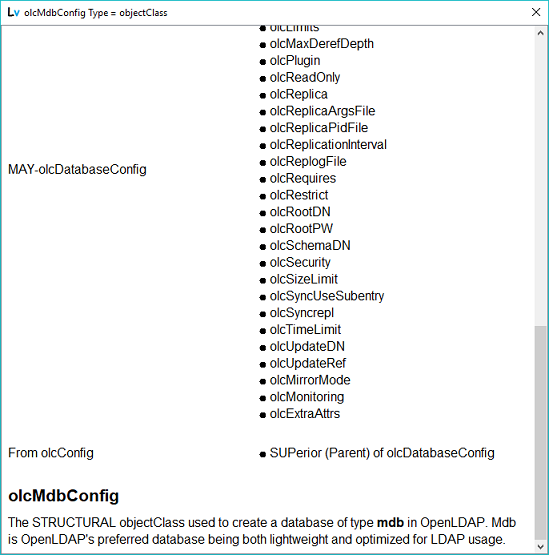

LDAPviewer allows the user to display information about supported objects using any one of three methods:
In Table Editor right clicking in the left (attribute name) or right (attribute value) column will bring up a context menu, selecting Object Definition will display the object definition.
In HTML Editor right clicking any attribute will display its Object Definition.
Using the View Object item from the View menu.
When the Object Definition is displayed LDAPviewer will also check in the help/fragments (help\fragments) directory for a file with the name lower-case-object-name.html and if present will add the file contents to the standard object description. For example, if the Object Definition is requested for the attribute homePhone then LDAPviewer will look for, in the help/fragments (help\fragments) directory, a file with the name homephone.html (help\fragments\homephone.html or help/fragments/homephone.html).
The feature is intended to allow users to provide additional descriptive material about either the ways standard attributes or objectClasses are used within an application or about custom attributes or objectClasses.
Note: In the case where an object has an alias, for instance, cn and its alias commonName, LDAPviewer will only use the primary name not the alias name. So in this case LDAPviewer will look for a file with the name cn.html and will not look for a file with a name commonname.html.
An example of this customization:

The contents of files in help/fragments are html fragments and are displayed inside a <td> </td> sequence (a table cell). The HTML fragments should be designed to format and display information (including images and links). Specifically, the HTML fragment must not include <html>, <head> or <body> tags or their corresponding closing tags. A simple example fragment is shown below:
<h1>myObject (myAliasObjectName)</h1> <p>blah, blah.....</p> <p>more blah...</p>
Note: In the above example, assuming myOject does exist, the HTML fragment would be contained in a file whose name would be myobject.html.
While the above fragment shows trivial use of HTML any valid HTML 4.01 formatting may be used including ul, ol, table tags, a (anchor) with corresponding hyperlinks and img tags (images must be loaded from the fragment directory, relative image references are not supported).
Note CSS related tags, such as <style>, <class> and <span> are not supported.
If Object Definition is clicked in the right-hand (attribute value) column for an attribute of objectClass, structuralObjectClass, supportedControl, supportedFeatures or supportedExtension then the Object Definition for the item displayed in the attribute value column will be displayed. Thus, if the left-hand column (attribute name) shows an attribute of structuralObjectClass and the right-hand column (attribute value) shows a value of inetOrgPerson the Object Definition of inetOrgPerson will be displayed. LDAPviewer will, in this case, look for a file named inetorgperson.html in the help/fragment directory. Right clicking in the left-hand column (attribute name). in this case, will display, as expected, the Object Definition for the attribute structuralObjectClass (and LDAPviewer will look for a file named structuralobjectclass.html).
In all other cases selecting Object Definition in either the right (attribute value) or left-hand (attribute name) colums will display the selected attribute definition.
© LV Project 2016. Creative Commons Attribution 4.0 International License.